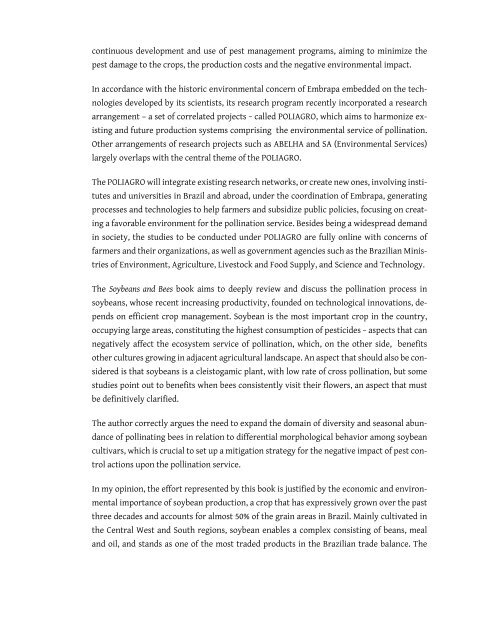Soybean and Bees
You also want an ePaper? Increase the reach of your titles
YUMPU automatically turns print PDFs into web optimized ePapers that Google loves.
continuous development <strong>and</strong> use of pest management programs, aiming to minimize the<br />
pest damage to the crops, the production costs <strong>and</strong> the negative environmental impact.<br />
In accordance with the historic environmental concern of Embrapa embedded on the technologies<br />
developed by its scientists, its research program recently incorporated a research<br />
arrangement – a set of correlated projects − called POLIAGRO, which aims to harmonize existing<br />
<strong>and</strong> future production systems comprising the environmental service of pollination.<br />
Other arrangements of research projects such as ABELHA <strong>and</strong> SA (Environmental Services)<br />
largely overlaps with the central theme of the POLIAGRO.<br />
The POLIAGRO will integrate existing research networks, or create new ones, involving institutes<br />
<strong>and</strong> universities in Brazil <strong>and</strong> abroad, under the coordination of Embrapa, generating<br />
processes <strong>and</strong> technologies to help farmers <strong>and</strong> subsidize public policies, focusing on creating<br />
a favorable environment for the pollination service. Besides being a widespread dem<strong>and</strong><br />
in society, the studies to be conducted under POLIAGRO are fully online with concerns of<br />
farmers <strong>and</strong> their organizations, as well as government agencies such as the Brazilian Ministries<br />
of Environment, Agriculture, Livestock <strong>and</strong> Food Supply, <strong>and</strong> Science <strong>and</strong> Technology.<br />
The <strong>Soybean</strong>s <strong>and</strong> <strong>Bees</strong> book aims to deeply review <strong>and</strong> discuss the pollination process in<br />
soybeans, whose recent increasing productivity, founded on technological innovations, depends<br />
on efficient crop management. <strong>Soybean</strong> is the most important crop in the country,<br />
occupying large areas, constituting the highest consumption of pesticides − aspects that can<br />
negatively affect the ecosystem service of pollination, which, on the other side, benefits<br />
other cultures growing in adjacent agricultural l<strong>and</strong>scape. An aspect that should also be considered<br />
is that soybeans is a cleistogamic plant, with low rate of cross pollination, but some<br />
studies point out to benefits when bees consistently visit their flowers, an aspect that must<br />
be definitively clarified.<br />
The author correctly argues the need to exp<strong>and</strong> the domain of diversity <strong>and</strong> seasonal abundance<br />
of pollinating bees in relation to differential morphological behavior among soybean<br />
cultivars, which is crucial to set up a mitigation strategy for the negative impact of pest control<br />
actions upon the pollination service.<br />
In my opinion, the effort represented by this book is justified by the economic <strong>and</strong> environmental<br />
importance of soybean production, a crop that has expressively grown over the past<br />
three decades <strong>and</strong> accounts for almost 50% of the grain areas in Brazil. Mainly cultivated in<br />
the Central West <strong>and</strong> South regions, soybean enables a complex consisting of beans, meal<br />
<strong>and</strong> oil, <strong>and</strong> st<strong>and</strong>s as one of the most traded products in the Brazilian trade balance. The


